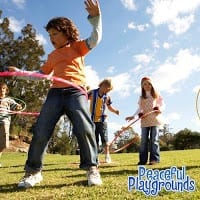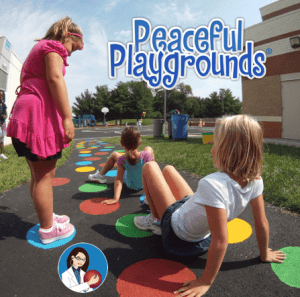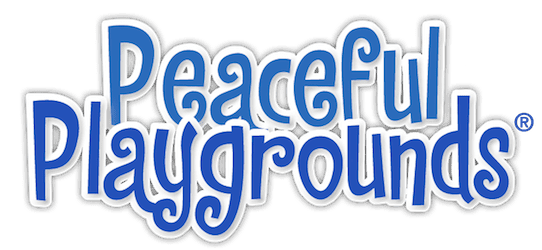Moorpark Acorn News
10-28-2011
New program in school district battles bullying
By Darleen Principe
Moorpark kids are learning how to keep the peace on the playground, one conflict at a time thanks to new PEP Grant.
In an effort to battle bullying and teach basic conflict-resolution skills, the Moorpark Unified School District is implementing a new program this year throughout its six elementary schools.
The Peaceful Playground Program, which was instituted as a joint effort between district coordinators for the Carol M. White Physical Education Program (PEP) Grant and the federal School Counseling Program grant, is designed to maximize physical activity and enhance learning during play times.
Leslie Seifert-De Los Santos, PEP Grant project director for MUSD, said the program consists of various new, positive blacktop activities and games designed to keep kids busy during recess— ultimately reducing the opportunity for conflict.
“And if a conflict does happen, there are ‘peaceful steps’ the kids can take,” she said. “We’ve designed a ‘peaceful path’ right on the playground. It’s designed so that when the kids get into a conflict, rather than giving them a time out, they take a series of steps to control their emotions and learn what they did wrong.”
Last December, MUSD received about $900,000 in PEP grant funds to enhance physical education in the K-5 curriculum. The grant was part of first lady Michelle Obama’s “Let’s Move!” initiative, which is aimed at addressing childhood obesity across the nation.
Last school year, grant coordinators used some of the money to purchase the Game Day P.E. program, which provides a structured physical education regimen, on-site teacher training and a nutritional education curriculum.
The 2011- 12 school year marks the second of the grant’s three operational years, where funds were used to purchase new Peaceful Playground equipment and curriculum materials for all six schools in the district.
The School Counseling Program grant, also in its second year at MUSD, was used to help train the teachers and students at each site for successful implementation of the Peaceful Playground.
Deonna Armijo, the district’s PEP teacher trainer, said MUSD’s maintenance staff and volunteer Eagle Scouts went to all the elementary schools over the summer and added new markings on the playgrounds.
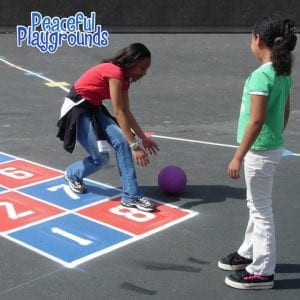
Ball Hopscotch
“For example, they painted a large circle—rather than a typical circle, it has different shapes and colors inside of it,” Armijo said. “Each marking has two or three different games attached to it.
“There’s a giant four-square that has number grids. There are also letter grids where the kids can work on their spelling.”
Vicky Yasenchok, principal at Peach Hill Academy, said a giant map of the United States is painted on the playground.
“Fifth grade is learning all the states and capitals as part of their regular curriculum,” Yasenchok said. “During recess one of our campus aides had the kids stand on the states, and then they had to tell her what the capital was.
“So what’s happening in the classroom is also happening on the playground.”
Conflict resolution
In addition to the new blacktop games, the Peaceful Playground program includes outdoor signs, student training cards, awards and other training materials.
Peach Hill Academy, which has fully implemented the program, designated a part of its playground as the “Conflict Corral,” Seifert-De Los Santos said.
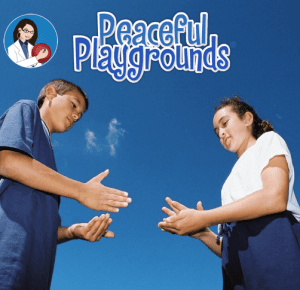
Another designated space on the playground is the “peaceful path,” which is marked with different strategies for personal reflection.
“The path is really for when a kid is upset,” the project director said. “Instead of making them sit down and think about what they’ve done, they get to move around while they’re doing it. They take a deep breath, they count backwards—they learn different strategies for calming down.”
At the end of the path, the child reports back to the adult who sent them there so they can reflect on what they did.
It also teaches the kids how to take ownership of their decisions, Seifert-De Los Santos said.
Although the program was implemented just this school year, Yasenchok said she’s already noticed a difference in the way children interact with one another on the playground.
While making rounds during recess on Monday, the principal said she noticed a conflict beginning between a few children.
One of the students, who was getting noticeably upset, took the initiative to walk down the “peaceful path” to “calm down and figure it out,” she said.
“I watched him as he was able to integrate himself back into the game,” Yasenchok said.
The Peaceful Playground has reduced the number of students coming into the office for misbehavior at Peach Hill, she said.
“It’s wonderful,” Yasenchok said. “I think it’s been very productive. And parents have been very pleased. Since the signs have gone up, I’ve been hearing them talk about the different strategies.
“As a principal, I’m so thankful to both of the grants. If it wasn’t for them, I wouldn’t know how we could have implemented this.”

